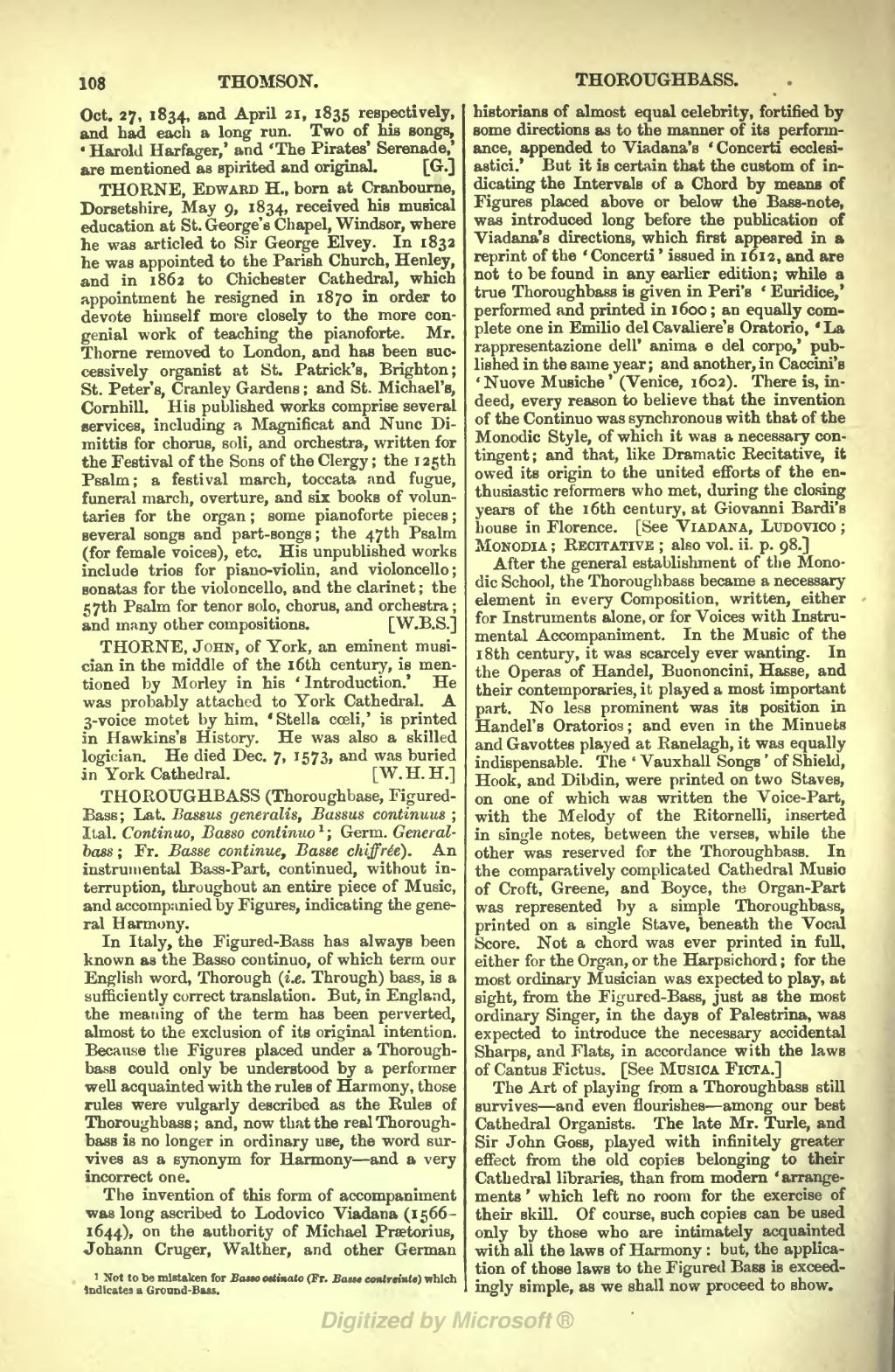Oct. 27, 1834, and April 21, 1835 respectively, and had each a long run. Two of his songs, 'Harold Harfager,' and 'The Pirates' Serenade,' are mentioned as spirited and original.
THORNE, Edward H., born at Cranbourne, Dorsetshire, May 9, 1834, received his musical education at St. George's Chapel, Windsor, where he was articled to Sir George Elvey. In 1832 he was appointed to the Parish Church, Henley, and in 1862 to Chichester Cathedral, which appointment he resigned in 1870 in order to devote himself more closely to the more congenial work of teaching the pianoforte. Mr. Thorne removed to London, and has been successively organist at St. Patrick's, Brighton; St. Peter's, Cranley Gardens; and St. Michael's, Cornhill. His published works comprise several services, including a Magnificat and Nunc Dimittis for chorus, soli, and orchestra, written for the Festival of the Sons of the Clergy; the 125th Psalm; a festival march, toccata and fugue, funeral march, overture, and six books of voluntaries for the organ; some pianoforte pieces; several songs and part-songs; the 47th Psalm (for female voices), etc. His unpublished works include trios for piano-violin, and violoncello; sonatas for the violoncello, and the clarinet; the 57th Psalm for tenor solo, chorus, and orchestra; and many other compositions.
THORNE, John, of York, an eminent musician in the middle of the 16th century, is mentioned by Morley in his 'Introduction.' He was probably attached to York Cathedral. A 3-voice motet by him, 'Stella coeli,' is printed in Hawkins's History. He was also a skilled logician. He died Dec. 7, 1573, and was buried in York Cathedral.
THOROUGHBASS (Thoroughbase, Figured-Bass; Lat. Bassus generalis, Bassus continuus; Ital. Continuo, Basso continuo[1]; Germ. General-bass; Fr. Basse continue, Basse chiffrée). An instrumental Bass-Part, continued, without interruption, throughout an entire piece of Music, and accompanied by Figures, indicating the general Harmony.
In Italy, the Figured-Bass has always been known as the Basso continuo, of which term our English word, Thorough (i.e. Through) bass, is a sufficiently correct translation. But, in England, the meaning of the term has been perverted, almost to the exclusion of its original intention. Because the Figures placed under a Thorough-bass could only be understood by a performer well acquainted with the rules of Harmony, those rules were vulgarly described as the Rules of Thoroughbass; and, now that the real Thoroughbass is no longer in ordinary use, the word survives as a synonym for Harmony—and a very incorrect one.
The invention of this form of accompaniment was long ascribed to Lodovico Viadana (1566–1644), on the authority of Michael Praetorius, Johann Cruger, Walther, and other German historians of almost equal celebrity, fortified by some directions as to the manner of its performance, appended to Viadana's 'Concerti ecclesiastici.' But it is certain that the custom of indicating the Intervals of a Chord by means of Figures placed above or below the Bass-note, was introduced long before the publication of Viadana's directions, which first appeared in a reprint of the 'Concerti' issued in 1612, and are not to be found in any earlier edition; while a true Thoroughbass is given in Peri's 'Euridice,' performed and printed in 1600; an equally complete one in Emilio del Cavaliere's Oratorio, 'La rappresentazione dell' anima e del corpo,' published in the same year; and another, in Caccini's 'Nuove Musiche' (Venice, 1602). There is, indeed, every reason to believe that the invention of the Continuo was synchronous with that of the Monodic Style, of which it was a necessary contingent; and that, like Dramatic Recitative, it owed its origin to the united efforts of the enthusiastic reformers who met, during the closing years of the 16th century, at Giovanni Bardi's house in Florence. [See Viadana, Ludovico; Monodia; Recitative; also vol. ii. p. 98.] [App. p.799 "add that the first use of a thoroughbass appears to be in a work by an English composer, Richard Dering, who published a set of 'Cantiones Sacrae' at Antwerp in 1597, in which a figured bass is employed. See Dering in Appendix, vol. iv. p. 612b."]
After the general establishment of the Monodic School, the Thoroughbass became a necessary element in every Composition, written, either for Instruments alone, or for Voices with Instrumental Accompaniment. In the Music of the 18th century, it was scarcely ever wanting. In the Operas of Handel, Buononcini, Hasse, and their contemporaries, it played a most important part. No less prominent was its position in Handel's Oratorios; and even in the Minuets and Gavottes played at Ranelagh, it was equally indispensable. The 'Vauxhall Songs' of Shield, Hook, and Dibdin, were printed on two Staves, on one of which was written the Voice-Part, with the Melody of the Ritornelli, inserted in single notes, between the verses, while the other was reserved for the Thoroughbass. In the comparatively complicated Cathedral Music of Croft, Greene, and Boyce, the Organ-Part was represented by a simple Thoroughbass, printed on a single Stave, beneath the Vocal Score. Not a chord was ever printed in full, either for the Organ, or the Harpsichord; for the most ordinary Musician was expected to play, at sight, from the Figured-Bass, just as the most ordinary Singer, in the days of Palestrina, was expected to introduce the necessary accidental Sharps, and Flats, in accordance with the laws of Cantus Fictus. [See Musica Ficta.]
The Art of playing from a Thoroughbass still survives—and even flourishes—among our best Cathedral Organists. The late Mr. Turle, and Sir John Goss, played with infinitely greater effect from the old copies belonging to their Cathedral libraries, than from modern 'arrangements' which left no room for the exercise of their skill. Of course, such copies can be used only by those who are intimately acquainted with all the laws of Harmony: but, the application of those laws to the Figured Bass is exceedingly simple, as we shall now proceed to show.
- ↑ Not to be mistaken for Baso ostinato (Fr. Basse contreinte) which indicates a Ground-Bass.
